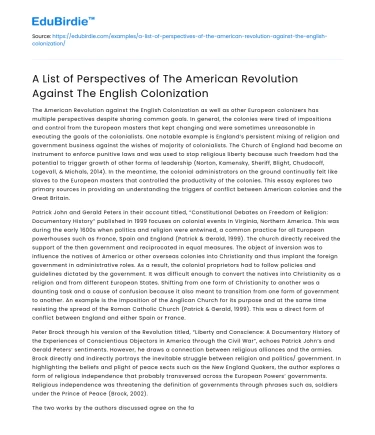The American Revolution against the English Colonization as well as other European colonizers has multiple perspectives despite sharing common goals. In general, the colonies were tired of impositions and control from the European masters that kept changing and were sometimes unreasonable in executing the goals of the colonialists. One notable example is England’s persistent mixing of religion and government business against the wishes of majority of colonialists. The Church of England had become an instrument to enforce punitive laws and was used to stop religious liberty because such freedom had the potential to trigger growth of other forms of leadership (Norton, Kamensky, Sheriff, Blight, Chudacoff, Logevall, & Michals, 2014). In the meantime, the colonial administrators on the ground continually felt like slaves to the European masters that controlled the productivity of the colonies. This essay explores two primary sources in providing an understanding the triggers of conflict between American colonies and the Great Britain.
Patrick John and Gerald Peters in their account titled, “Constitutional Debates on Freedom of Religion: Documentary History” published in 1999 focuses on colonial events in Virginia, Northern America. This was during the early 1600s when politics and religion were entwined, a common practice for all European powerhouses such as France, Spain and England (Patrick & Gerald, 1999). The church directly received the support of the then government and reciprocated in equal measures. The object of inversion was to influence the natives of America or other overseas colonies into Christianity and thus implant the foreign government in administrative roles. As a result, the colonial proprietors had to follow policies and guidelines dictated by the government. It was difficult enough to convert the natives into Christianity as a religion and from different European States. Shifting from one form of Christianity to another was a daunting task and a cause of confusion because it also meant to transition from one form of government to another. An example is the imposition of the Anglican Church for its purpose and at the same time resisting the spread of the Roman Catholic Church (Patrick & Gerald, 1999). This was a direct form of conflict between England and either Spain or France.
Save your time!
We can take care of your essay
- Proper editing and formatting
- Free revision, title page, and bibliography
- Flexible prices and money-back guarantee
Peter Brock through his version of the Revolution titled, “Liberty and Conscience: A Documentary History of the Experiences of Conscientious Objectors in America through the Civil War”, echoes Patrick John’s and Gerald Peters’ sentiments. However, he draws a connection between religious alliances and the armies. Brock directly and indirectly portrays the inevitable struggle between religion and politics/ government. In highlighting the beliefs and plight of peace sects such as the New England Quakers, the author explores a form of religious independence that probably transversed across the European Powers’ governments. Religious independence was threatening the definition of governments through phrases such as, soldiers under the Prince of Peace (Brock, 2002).
The two works by the authors discussed agree on the fact religion and civil government were intertwined and expected to work together as a system of administration. The implied dependence on one another was expected to stand under all areas of governance because the relationship guaranteed predictability of outcomes. Stability, expansion of colonies and protection of boundaries relied on constant administration over colonies. Furthermore, both publications also highlight a form of dissenting behavior. Patrick John and Gerald Peters express the resistance by colonialists based on the intertwining nature of civil government and religion. Peter Brock on the other hand, provides an interesting angle that portrays religious disagreement with the beliefs of the civil government, through a resistance to fight by peace sects, despite affiliation to particular warring European countries.
In conclusion, the road to revolution stems from an increasing imbalance of interests for parties within the English colonization. The colonialists felt they had a better chance of understanding and satisfying the needs of the entire stakeholders to their pursuits. However, the European Masters such as the Great Britain and France enforced their interests mingled with religion, as a priority to the existence of colonies. As a result, general implementation of rules and activities demanded by the European Masters gradually generated a disgruntled group of colonialists.






 Stuck on your essay?
Stuck on your essay?

